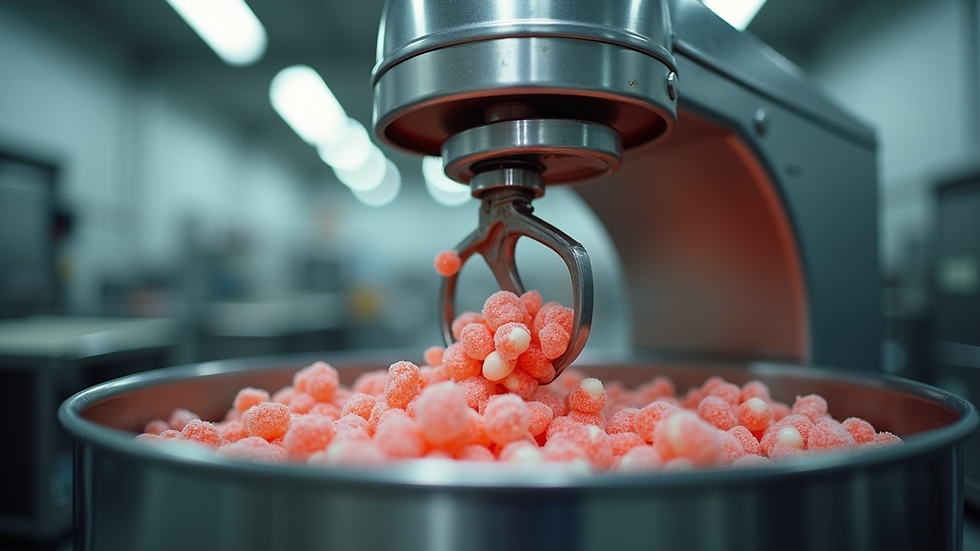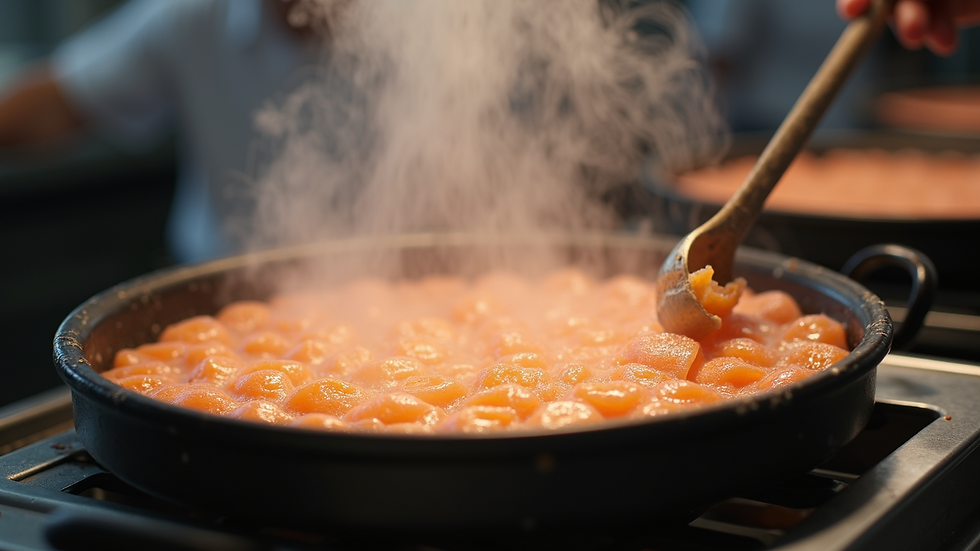The Science Behind Effective Mixing in Candy Production
- Usman Akram

- Jul 26
- 4 min read
In the world of candy production, the process of mixing is more than just a simple combination of ingredients. It’s a complex science that directly influences the texture, flavor, and quality of the finished product. Understanding the intricacies of mixing can lead to improvements in production efficiency, flavor consistency, and product quality. This blog post will explore the science behind effective mixing in candy production and its critical role in confectionery machinery.
Understanding Confectionery Machinery
Confectionery machinery plays a fundamental role in the production of candy. It encompasses various machines designed for different processing steps including cooking, cooling, and, most importantly, mixing. The mixing process is essential for ensuring that all ingredients are evenly distributed, leading to a uniform product.
Without effective mixing, ingredients can settle or clump, resulting in inconsistent flavor and texture—something no candy manufacturer wants. Let's delve into the key factors that define effective mixing in candy production and how they relate to the machinery used.

The Importance of Mixing in Candy Production
Effective mixing contributes to several critical attributes of candy, including texture, flavor, and appearance. During the mixing process, ingredients such as sugars, flavorings, and colorings blend together to form the desired candy mass.
A well-mixed batch will ensure that each piece of candy tastes the same and has a consistent texture. Texture is especially important in confectionery products. For instance, gummy candies need a specific elasticity, while chocolate must have a silky smoothness. Therefore, achieving the right mixing parameters enhances both quality and consumer satisfaction.
Moreover, inconsistent mixing can lead to "hot spots" in the candy mixture, where ingredients could not be uniformly blended. This can result in localized areas of extreme sweetness or a lack of flavor, significantly diminishing the overall product quality.

Key Factors Influencing Effective Mixing
Effective mixing relies on various factors including mixing time, speed, and equipment design. Each of these factors can significantly impact the final product’s quality, making it crucial for manufacturers to optimize them.
Mixing Time: The duration for which the ingredients are mixed plays a significant role in achieving a uniform mixture. If the mixing time is too short, the ingredients may not fully integrate, while excessive mixing can lead to a change in texture or even affect the flavors.
Mixing Speed: The rate at which mixing occurs also affects the final product. For example, higher speeds create more friction, which can lead to heat generation—potentially altering certain ingredients.
Equipment Design: The design of the mixing equipment can greatly influence mixing efficiency. Effective industrial mixer design supports the proper folding and blending of ingredients to ensure no clumping or uneven distribution occurs.
Uniformity and Homogeneity in Mixtures
One of the main goals of mixing is to achieve uniformity and homogeneity across batches. Uniformity refers to the even distribution of ingredients, while homogeneity refers to a consistent composition that results in similar properties throughout the mixture.
Using the right machine can help ensure that all components reach every part of the mixture evenly. For example, some mixers utilize specific blade designs that facilitate thorough mixing without damaging sensitive ingredients like fragile flavorings or colors.
Mixing Techniques and Their Diversities
In candy production, various mixing techniques are employed based on the specific type of candy being produced.
Batch Mixing: This involves mixing a specific batch of ingredients and is common in small to medium-sized production. Batch mixing allows for careful monitoring and adjustments.
Continuous Mixing: Ideal for large-scale operations, continuous mixing involves a steady feed of ingredients with concurrent mixing. This method promotes efficiency but requires better control systems to ensure a consistent product.
Planetary Mixing: Used often in chocolate and cream-based candies, this technique involves moving both the ingredients and the mixer components in different directions, promoting superior blending capabilities.
Understanding these techniques is crucial for candy producers seeking to optimize their mixing processes and improve product quality.
The Role of Temperature and Environmental Conditions
Temperature control is another vital aspect of effective mixing in candy production. Certain ingredients may be sensitive to temperature fluctuations, which can impact the mixing process and the final product.
For instance, if a candy mixture is heated too much during mixing, it can lead to premature crystallization of sugar, resulting in a grainy texture. On the other hand, a cooler mixture might not blend properly, affecting the homogeneity of flavor and texture.
Environmental conditions, such as humidity, can also influence the behavior of ingredients and should be closely monitored to ensure successful mixing.

Common Challenges in Candy Mixing and Solutions
Even with an understanding of the mixing science, manufacturers often face challenges during the mixing process. Here are a few common issues and their solutions:
Inconsistent Mixtures: If the mixture isn't homogeneous, consider adjusting the mixing time or speed. Additionally, analyze the equipment design to ensure it's suitable for the specific ingredients being used.
Ingredient Settling: Ensure that mixing occurs at optimal speeds to lead to proper suspension of solid ingredients. Regular machinery maintenance can also prevent issues of settling and achieve a consistently well-mixed product.
Temperature Issues: Implement strict temperature control measures during mixing to avoid unwanted crystallization or ingredient degradation.
Future Trends in Candy Mixing
The candy industry is continually evolving, and so are the technologies used in mixing. Automation, enhanced monitoring systems, and improved machine designs are expected to dominate the future of candy mixing.
For example, newer mixers will likely incorporate smart technology that adapts to ingredient types and environmental conditions in real time, leading to enhanced mixing precision. Additionally, sustainability is becoming more important; thus, greener practices in candy production and mixing might become a significant focus.
Enhancing Your Mixing Process
In conclusion, mastering the science of effective mixing is crucial for any candy manufacturer aiming to produce high-quality products. By understanding the factors influencing mixing and implementing best practices, producers can create a more consistent and enjoyable product for consumers.
Remember that the right industrial mixer design and staying ahead of industry trends can make all the difference. By continually refining your mixing processes, you can ensure your candies stand out in a competitive market and delight consumers with every bite.




Comments